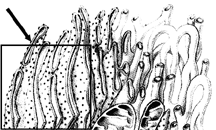Frequency-dependent selection acts to decrease the frequency of which phenotype in a population?
a. the least common phenotype
b. the phenotype at an extreme of the normal distribution
c. the most conspicuous phenotype
d. the most common phenotype
e. the most camouflaged phenotype
D
You might also like to view...
The pea plant was an excellent choice for
Mendel's experiments because a. true-breeding varieties were available. b. the plant can self-fertilize. c. it can be cross-fertilized. d. true-breeding varieties were available, and it can be cross-fertilized. e. true-breeding varieties were available, the plant can self-fertilize, and it can be crossfertilized.
Refer to Figure 4-2. The cellular structure indicated by the arrow is responsible for:a
lipid and fatty acid metabolism.
b. protein synthesis.
c. digestion of unused organelles.
d. replication.
e. cellular respiration
The main reason scientists thought that proteins, rather than DNA, were the carriers of genetic material
in the cell was:a. their presence within the nucleus. b. their abundance within the cell. c. the large number of possible amino acid combinations. d. their ability to self replicate within the cytoplasm. e. their ability to be exported from the cell.
You are about to start a multiyear experiment in a laboratory that works with poliovirus. Although the chance of exposure is low, you are still required to get immunized. What type of immunity now protects you?
A) artificially acquired passive immunity B) artificially acquired active immunity C) naturally acquired passive immunity D) naturally acquired active immunity